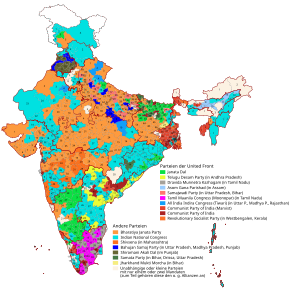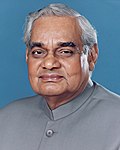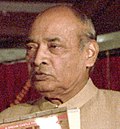1996 Indian general election
This article needs additional citations for verification. (July 2021) |
| ||||||||||||||||||||||||||||||||||||||||||||||||||||||||||||||||||||
543 of the 545 seats in the Lok Sabha 272 seats needed for a majority | ||||||||||||||||||||||||||||||||||||||||||||||||||||||||||||||||||||
|---|---|---|---|---|---|---|---|---|---|---|---|---|---|---|---|---|---|---|---|---|---|---|---|---|---|---|---|---|---|---|---|---|---|---|---|---|---|---|---|---|---|---|---|---|---|---|---|---|---|---|---|---|---|---|---|---|---|---|---|---|---|---|---|---|---|---|---|---|
| Registered | 592,572,288 | |||||||||||||||||||||||||||||||||||||||||||||||||||||||||||||||||||
| Turnout | 57.94% ( | |||||||||||||||||||||||||||||||||||||||||||||||||||||||||||||||||||
| ||||||||||||||||||||||||||||||||||||||||||||||||||||||||||||||||||||
 Results by constituency | ||||||||||||||||||||||||||||||||||||||||||||||||||||||||||||||||||||
| ||||||||||||||||||||||||||||||||||||||||||||||||||||||||||||||||||||
General elections were held in India on 27 April, 2 May and 7 May 1996 to elect the members of the eleventh Lok Sabha. The elections resulted in a hung parliament with no single party having a clear majority. The Bharatiya Janata Party, which had won the most seats, formed a short-lived government under Prime Minister Atal Bihari Vajpayee. However, two weeks later the United Front coalition was able to secure a parliamentary majority and H. D. Deve Gowda of Janata Dal became Prime Minister. In 1997 Inder Kumar Gujral, also from the United Front, succeeded Gowda as Prime Minister. Due to the instability, early elections were held in 1998. The elections were the first since 1980 in which every states' seats were elected in a single election period.
Background
The
The government was further weakened by a series of major scandals breaking less than 12 months from the election. In July 1995 it was found a former Congress(I) youth leader had murdered his wife and tried to destroy the evidence by stuffing her corpse into a
Campaign
The elections triggered a significant realignment of political forces in Indians, with all-India parties attempting to construct widespread regional coalitions with minor parties in order to secure a central majority. Such political negotiations were to become an increasingly necessary process in Indian politics over the next two decades as the dominance of the INC(I) declined and smaller, ethnic and regional parties took its place. The Bharatiya Janata Party, led by
The so-called "Third Force" during the 1996 elections was the
In January only a few months before the election, a major scandal erupted: the
The BJP ran a campaign centred around a four-point plan which aimed for probity of public life, self-reliance in the economy, social harmony and greater security. It strongly advocated an economic plan which would significantly scale back government intervention and encourage capital investment and creation. In the backdrop of the 1992 demolition of the Babri Masjid, BJP stressed on the role of Hindutva in its vision for India, creating a more Hindu-orientated state by removing the provisions of secularism & making Hinduism the country's state religion, implementing a nationwide ban on cow slaughter, abolishing personal laws of non-Hindus by introducing a uniform civil code and removing the special status of Kashmir alongside construction of the Ram-mandir as its main agenda. The Congress(I) Party attempted to campaign on its foreign policy record, its handling of the numerous natural and ethnic crises that had emerged over the past five years, and on better concessions for ethnic minorities and empowering the state governments. It additionally stressed the economic gains already made by the government due to its liberalization policies post 1992. However it drew flak for promising re-construction of the demolished mosque at the disputed site of Ayodhya in its electoral manifesto, leading the BJP to accuse the Congress (Indira) of indulging in Muslim appeasement & fostering Hinduphobia. The Janata Dal and the National Front campaigned on maintaining a strong public sector though with some commitment to deregulation and anti-corruption measures while committing to implement the Mandal Commission report. It also pushed other more populist measures as well, such as more state-run infrastructure projects, subsidised fertilizer, and increased education investment.[7]
Results
The BJP capitalised on the communal polarisation that followed the demolition of Babri Masjid to win 161 Lok Sabha seats, making it the largest party in parliament.
Following Westminster custom, Indian President Shankar Dayal Sharma invited Atal Bihari Vajpayee as leader of the BJP to form a government. Sworn in on 15 May, the new Prime Minister was given two weeks to prove majority support in parliament. In the weeks leading up to the first confidence vote on 31 May, the BJP attempted to build a coalition by moderating positions to garner support from regional and Muslim parties, however sectarian issues and fears of certain nationalist policies of the BJP hampered efforts. On 28 May, Vajpayee conceded that he could not arrange support from more than 200 of the 545 members of parliament, and thus resigned rather than face the confidence vote, ending his 13-day government.[11]
The second largest party, the Indian National Congress (Indira), also declined to form a government. After Janata Dal leader V. P. Singh refused to become Prime Minister for a second time, CPI(M) leader & incumbent West Bengal Chief Minister Jyoti Basu was approached by the National Front to be its prime ministerial face, but the party politburo refused to endorse it (a decision which Basu later criticised as a "historic blunder") in order to affirm it's commitment towards establishing dictatorship of the proletariat. Basu put forward the name of Janata Dal leader & incumbent Karnataka Chief Minister H. D. Deve Gowda as the candidate for the Prime Minister post. Janata Dal and a bloc of smaller parties thus formed the United Front government,[10] with outside support from INC(I). Gowda resigned on 21 April 1997 due to withdrawal of support by the Indian National Congress [a] to pave way for I. K. Gujral, who maintained good relations with the Congress.
However the
Anglo-Indians 2 | | ||||||
|---|---|---|---|---|---|---|---|
| Total | 334,873,286 | 100.00 | 545 | ||||
| Valid votes | 334,873,286 | 97.54 | |||||
| Invalid/blank votes | 8,434,804 | 2.46 | |||||
| Total votes | 343,308,090 | 100.00 | |||||
| Registered voters/turnout | 592,572,288 | 57.94 | |||||
| Source: ECI | |||||||
Notes
- ^ After 1996, the Indian National Congress (Indira) dropped the suffix 'Indira' from its name, thereby becoming known as Indian National Congress
See also
- List of members of the 11th Lok Sabha
- Election Commission of India
- 1992 Indian presidential election
References
- ^ Vohra, N (October 1993). "Chapter 3.4, pp.3". The Vohra Committee Report.
- ISBN 978-0-7656-0712-6.
- ISBN 978-0-19-566833-9.
- ISBN 978-0-7619-9598-2.
- JSTOR 2645573.
- ISBN 978-0-7656-0712-6.
- ISBN 978-0-7656-0712-6.
- ISBN 978-0-330-39610-3
- ^ Elections 1996: 11th Lok Sabha elections saw eclipse of the National Constituency syndrome Archived 18 August 2016 at the Wayback Machine India Today, 31 May 1996
- ^ a b Hardgrave, Robert (1996). "1996 Indian Parliamentary Elections: What Happened? What Next?". University of Texas. Archived from the original on 7 August 2008. Retrieved 12 December 2008.
- ^ "India's prime minister resigns after 13 days". CNN. 28 May 1996. Archived from the original on 25 August 2004. Retrieved 12 December 2008.




